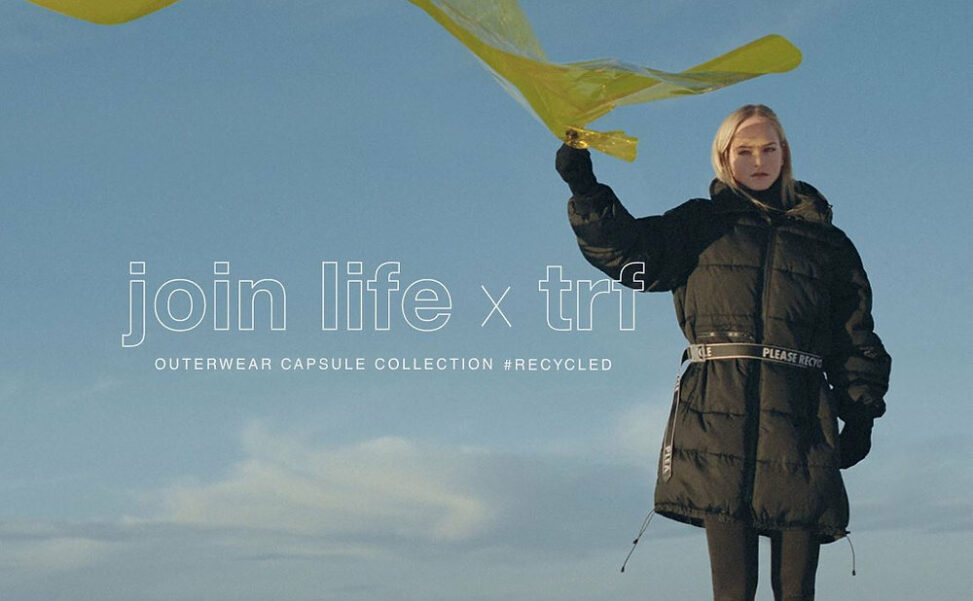This advertisement is a still image advertisement created by Zara, a popular fashion brand under their parent company Inditex. The advertisement promotes outerwear from Zara’s (TRF) Trafaluc collection for women specifically tailored from recycled materials. The movement puts emphasis on sustainability and that aligns with the “Join Life” movement, this ad is to market clothing made with environmentally friendly fabrics like recycled polyester and organic cotton. Zara came under fire for its vague sustainability claims when they launched the infamous eco-friendly collection “Join Life” and pledged to stop using toxic chemicals by 2020. Similar to H&M’s “conscious collection,” employing materials like “organic cotton,” “recycled wool,” and Tencel is insufficient to lessen its environmental impact when the vast bulk of its operations continue to be harmful to the environment (Assoune qtd. in Nguyen, pg. 35).
The ad shows an attractive female model, although unclear, she is looking to her left and seems to have a strong facial expression. Because of the theme of the advertisement, her expression could depict strong responsibility by the amount of waste in the clothing industry. The model is seen wearing an oversized black puffer coat with a “PLEASE RECYCLE” belt which emphasizes fabric being reused. She is standing outside with the clear blue sky behind her with clouds beneath. The model is holding a yellow/greenish plastic sheet and this depicts plastic waste being reused; the colors of the plastic against the blue sky seems to be opposite from the color wheel which makes it look soothing. The text “join life x trf” along with the text below it is displayed to the left of the model.
The composition of the advertisement is side to side, the main message is slightly centred and in big font in order to inform consumers/viewers about their campaign. The sub message “outerwear” also highlights which category of clothing it will be on. It also creates awareness about their recycling movement via their “#RECYCLED” model reflects their category of clothing which is outerwear by wearing a long coat and gloves. The model also emphasizes on their recycling movement by holding a piece of plastic as if to let the consumers/viewers know that parts of the clothing are made from recycled plastics, all the while being in the fashion trend. Wearing the belt that has a message “please recycle” also aligns with the company’s intention to spread awareness about recycling and also to their movement to use those recycled products into their clothing materials. For the top to bottom composition, the background being just the sky is to convey the impression that they are being more earth friendly. The quality of the advertisement is also clear.
The message of the advertisement: The “PLEASE RECYCLE” belt serves as a clear message for sustainability. The yellowish plastic the model is holding represents leftover materials that were eventually being reused. The way the model is holding the plastic up is similar to an activist, this could imply that she is showing consumers/viewers that plastic can be turned into something useful.
In my opinion, I found the advertisement simple, and it draws me in how the message is straight forward as well as how it is not overly designed. I think the message of this image is appealing for consumers who would want to make sustainable choices. However, for many young consumers, this image may not have a strong effect on them because many prefer clothing that are trending or fast fashion, which most of these clothings have non-sustainable friendly fabric.
Zara’s ‘Join Life’ collection promotes clothes made from “organic cotton, recycled wool, and Tencel. Inditex, Zara’s parent company is the largest retailer of fast fashion in the world and actively promotes the fashion throwaway culture” (Munir & Mohan, pg. 11). Because of this, Zara continues to face criticism for unsustainable fast fashion and accusations of greenwashing, even after introducing the Join Life movement and setting a goal of using only sustainable cotton and renewable energy by 2025 (Jha & Veeramani, 2021, p. 55). The company’s large manufacturing volume being roughly 20,000 styles each year, promotes a disposable fashion culture (Jordan qtd. in Jha & Veeramani, 2021, p. 57). In response to demands and customer complaints, Zara has made several changes. Although the brand has implemented recycling programs and increased supply chain transparency, these initiatives are frequently seen as inadequate (Bick et al, 2018 in Munir & Mohan, 2021, p. 28). Zara’s basic reliance on fast fashion hasn’t changed much, despite consumer demand and accusations of greenwashing pushing the company to implement more sustainability activities.
Although Zara’s efforts on sustainability has been shaped by consumers, the company’s aiming for economic strategy which promotes fast consumption and manufacturing has not been greatly affected which has restricted them of environmental developments.
SOURCES:
Jha, Srirang K., and S. Veeramani. “Sorting responsible business practices in fast fashion: a case study of Zara.” Journal of Management and Public Policy 12, no. 2 (2021): 54-58. https://doi.org/10.47914/jmpp.2021.v12i2.004
Munir, S., and V. Mohan. “Consumer Perceptions of Greenwashing: Lessons Learned from the Fashion Sector in the UAE.” Asian Journal of Business Ethics 11 (2022): 1–44. https://doi.org/10.1007/s13520-021-00140-z.
Nguyen, Ngoc. Fast Fashion & Greenwashing: The Worst Combination for Sustainability. 2023. https://www.researchgate.net/publication/373632703_Fast_Fashion_Greenwashing_The_Worst_Combination_for_Sustainability


Domenica Randich
In this critical analysis, the student explains how a clothes’ company: Zara, was accused of greenwashing when its Join Life campaign was made public due the inconsistencies of their regular production and their sustainable one; if your regular clothes are being mass produced, what is worth making one eco-friendly collection? This student discloses what Zara’s goal was with this advertisement, and at the same time, voicing their opinion about it.
Carefully inspecting the pictorial elements, they concluded this still-image reflects that being ecologically responsible was the company’s top priority and that through them, the costumer could also feel as if they were making a conscious decision. Even though they were no significant mentions of other concepts, this meticulous examination only shows how important it was for the student to properly explain greenwashing; statement that is evidenced by the appropriate use of fitting and scholarly quotations and the corresponding bibliography.
This text succeeds in describing how greenwashing is immersed in this company, while also considering how the composition and elements of the ad could mislead its targeted audience. In the paragraph this was mentioned, this student shared that they were drawn to the simple and straightforward message of the ad, and when I started to wonder how they were related to the ad and company’s audience, this thought was forgotten since they explained instead how costumers interested in the topic could be attracted to it, but not young ones because their interest of trending items.